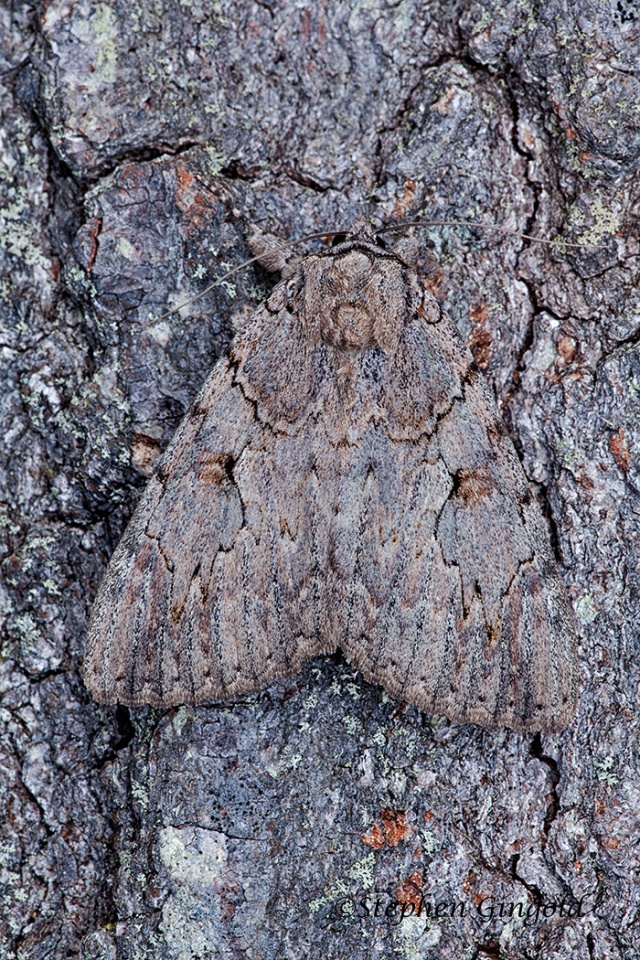Newly ID’d by the nice folks at BugGuide. AKA Catocala amatrix. I posted this on BG.N back in August of 2010 and someone found it while cleaning up during the quiet winter season and gave me an ID.
 This is a member of the Genus Catocala, which are known as underwings. When the forewings are spread to reveal the hindwings, we then see a wonderfully colorful display of red and black. I have yet to get a shot of the display.
This is a member of the Genus Catocala, which are known as underwings. When the forewings are spread to reveal the hindwings, we then see a wonderfully colorful display of red and black. I have yet to get a shot of the display.

The glorious displays on the hindwings have been a source of frequent fascination for me, having had the pleasure of seeing quite a few at our cabin in Minnesota…the sphinxes especially come to mind. But, obviously, when not displaying to attract soulmates, they keep them undercover so they’re more likely be left in peace. In fact, use your imagination: If you look at that marking in the middle of the left wing and imagine it inverted, isn’t that a nearly-perfect outline of a hand making a classic peace sign?
LikeLike
Well, as I am answering this on my Kindle, that suggestion was a little frustrating…no matter how you turn the tablet it keeps flipping the image right side up. I do see the symbol but mostly through the power of suggestion.
LikeLike
A good example of hiding in plain sight.
LikeLiked by 1 person
Something that many moths excel at.
LikeLike
This little gem doesn’t just blend in color-wise, it even mimics the cracks in the bark. Good for you for even spotting it. And thanks for the link to that fabulous hidden color. I never would have expected that.
LikeLike
Moths are wonderful and excel at disappearing into the woodwork, so to speak. And their variety is just full of all sorts of patterns and colors…I think they definitely rival butterflies. But their numbers and subtle variations make for challenging identification. Some are easy, but the majority drive me up a wall and I am very thankful to the folks at BugGuide and a few other groups that are so helpful. And…most do not eat wool. 🙂
LikeLike
This is an impressive example of blending in the surroundings. Steve, I’m glad you finally got an ID. And now your followers are also wiser. 🙂
LikeLiked by 1 person
Moth? What moth? 🙂 I have found a few that hide in crevices and surprise me when they move.
LikeLiked by 1 person
Who’d have suspect such bright color hidden below such good camouflage? Indeed, when it comes to colors, the bark is worse than the bright.
LikeLiked by 1 person
In this case I do think the color is for attracting a mate, but in many others the colors or patterns are arranged in such a way as to scare off a predator or resemble something else, as in the bird dropping moths.
LikeLike
Wow, outstanding! Really blends in too.
LikeLike
Thanks, Phil. It’s a good thing gators aren’t as hard to see.
LikeLike
I’m no entomologist … but as an evolutionary biologist, this one reminds me of Europe’s famous Peppered Moth (Biston betularia) of natural-selection-fame! D
LikeLiked by 1 person
I think that there could have been many choices to follow in the studies. The most frustrating part of insect, especially moth, ID is the variability within a genus and/or species which can be in response to so many factors.
LikeLiked by 1 person
Aren’t these lovely, Steve? I can never resist photographing them when I come across them. I think the colors of an underwing are for defense~ they flash them at the last moment to surprise a predator. I believe they find each other by scent.
LikeLiked by 1 person
I think you are probably correct about the defense purpose, Melissa. But it also might be a good mate attractor…survival of the fittest or in this case loveliest. 🙂 Yes, pheromones are a big part of attracting a mate. I always tried to not shower too much for fear of washing all mine down the drain. 🙂
LikeLike
Haha, I recently read that that is a strategy of some of our famous actors 🙂
LikeLiked by 1 person